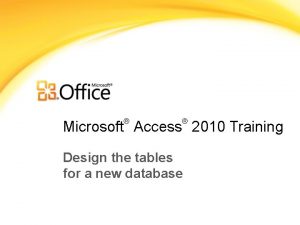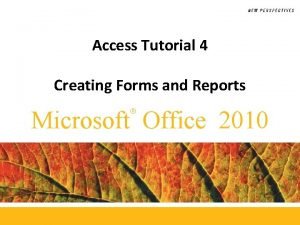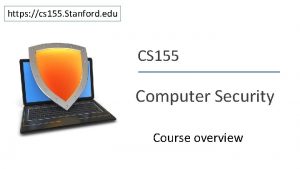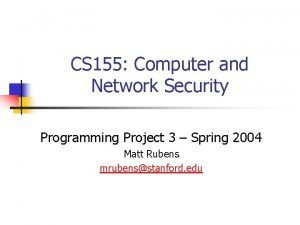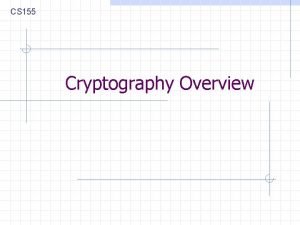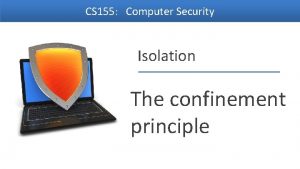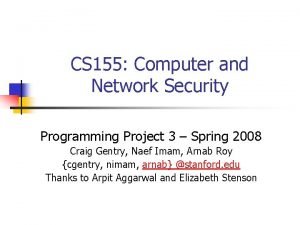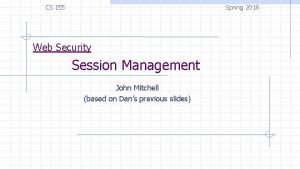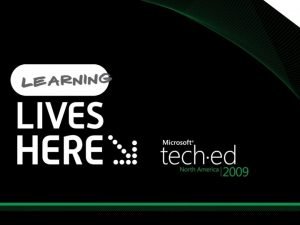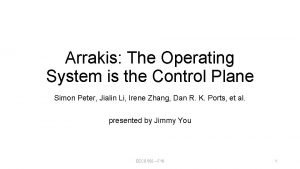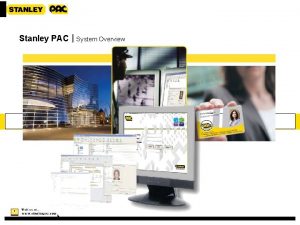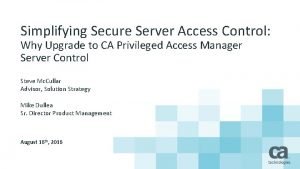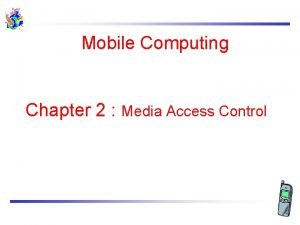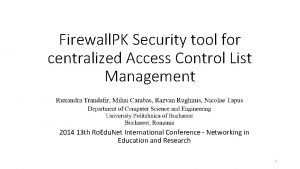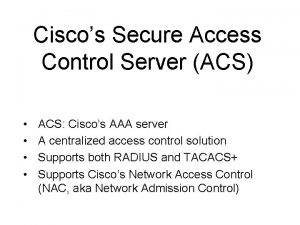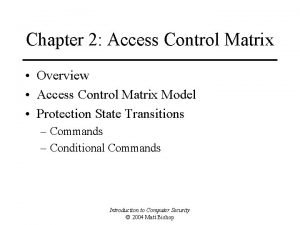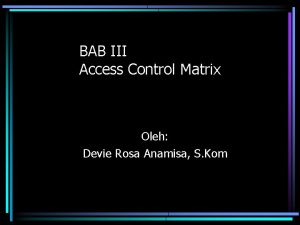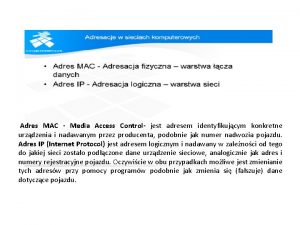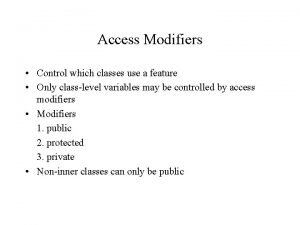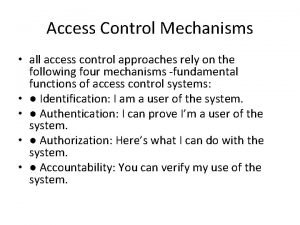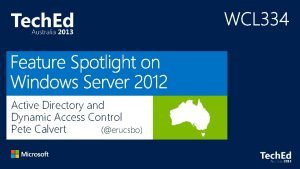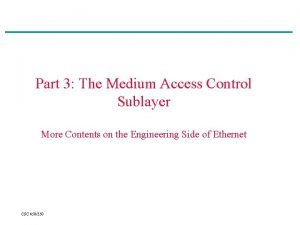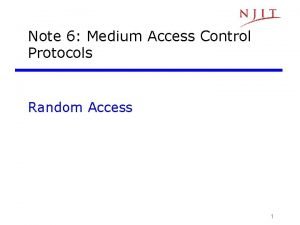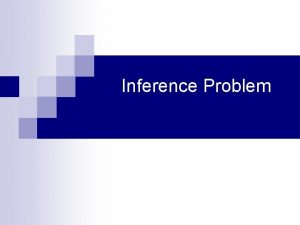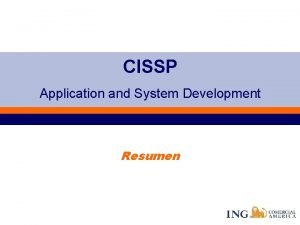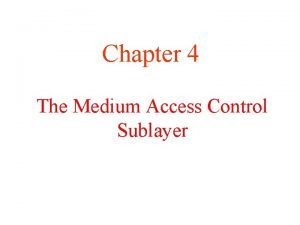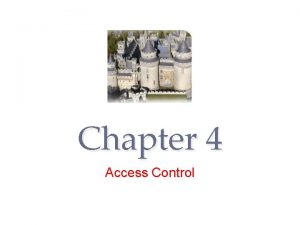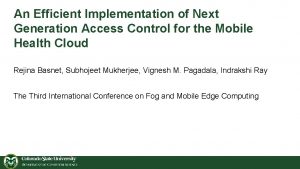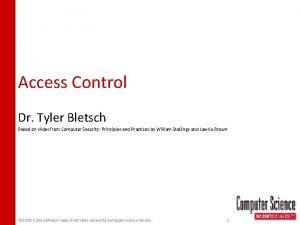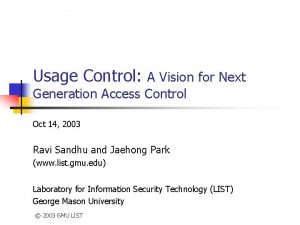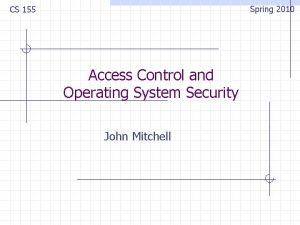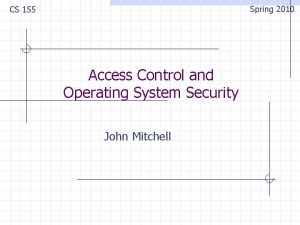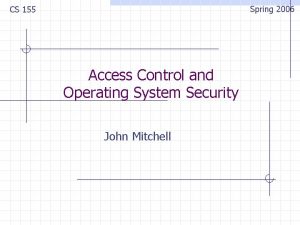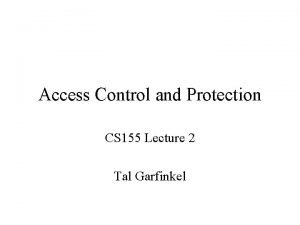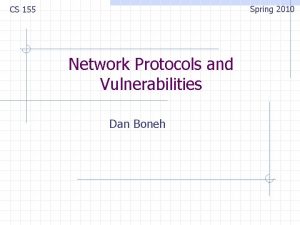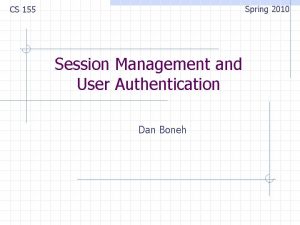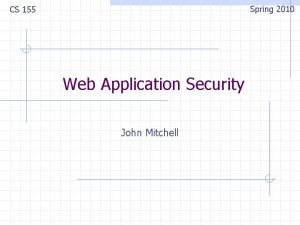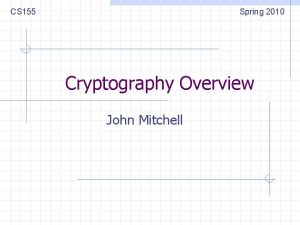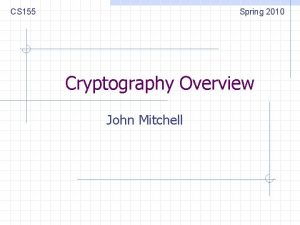Spring 2010 CS 155 Access Control and Operating




![Access control matrix [Lampson] Objects File 1 Subjects File 2 File 3 … File Access control matrix [Lampson] Objects File 1 Subjects File 2 File 3 … File](https://slidetodoc.com/presentation_image_h/f75a7da8ce39c251eca8fe0037e8aa2c/image-5.jpg)





































































- Slides: 74

Spring 2010 CS 155 Access Control and Operating System Security John Mitchell

Lecture goal: Cover background and concepts used in Android security model 2 IEEE Security and Privacy, Jan. -Feb. 2009

Outline Access Control Concepts n Matrix, ACL, Capabilities OS Mechanisms n Web browser (briefly) n n Multics “OS of the future” Protect content based on origins instead of user id w Ring structure n Amoeba w Distributed, capabilities n Unix w File system, Setuid n Windows w File system, Tokens, EFS 3 Android security model n n OS user-isolation applied to applications Reference monitor for inter-component communications

Access control Assumptions n System knows who the user is w Authentication via name and password, other credential n Access requests pass through gatekeeper (reference monitor) w System must not allow monitor to be bypassed Reference monitor User process access request ? policy 4 Resource
![Access control matrix Lampson Objects File 1 Subjects File 2 File 3 File Access control matrix [Lampson] Objects File 1 Subjects File 2 File 3 … File](https://slidetodoc.com/presentation_image_h/f75a7da8ce39c251eca8fe0037e8aa2c/image-5.jpg)
Access control matrix [Lampson] Objects File 1 Subjects File 2 File 3 … File n User 1 read write - - read User 2 write - - User 3 - - - read write read … User m read 5

Two implementation concepts Access control list (ACL) Store column of matrix with the resource n Capability User holds a “ticket” for each resource n Two variations n File 1 File 2 User 1 read write - User 2 write - User 3 - - read write … User m read w store row of matrix with user, under OS control w unforgeable ticket in user space Access control lists are widely used, often with groups Some aspects of capability concept are used in Kerberos, … 6 …

Capabilities Operating system concept n “… of the future and always will be …” Examples n n n Dennis and van Horn, MIT PDP-1 Timesharing Hydra, Star. OS, Intel i. APX 432, Eros, … Amoeba: distributed, unforgeable tickets References n Henry Levy, Capability-based Computer Systems http: //www. cs. washington. edu/homes/levy/capabook/ n 7 Tanenbaum, Amoeba papers

ACL vs Capabilities Access control list n n n Associate list with each object Check user/group against list Relies on authentication: need to know user Capabilities n Capability is unforgeable ticket w Random bit sequence, or managed by OS w Can be passed from one process to another n Reference monitor checks ticket w Does not need to know identify of user/process 8

ACL vs Capabilities User U Process P User U Process Q User U Process R 9 Capabilty c, d Process P Capabilty c Process Q Capabilty c Process R

ACL vs Capabilities Delegation n n Cap: Process can pass capability at run time ACL: Try to get owner to add permission to list? w More common: let other process act under current user Revocation n n ACL: Remove user or group from list Cap: Try to get capability back from process? w Possible in some systems if appropriate bookkeeping n n OS knows which data is capability If capability is used for multiple resources, have to revoke all or none … w Indirection: capability points to pointer to resource n 10 If C P R, then revoke capability C by setting P=0

Roles (also called Groups) Role = set of users n n Administrator, Power. User, Guest Assign permissions to roles; each user gets permission Role hierarchy Partial order of roles n Each role gets permissions of roles below n List only new permissions given to each role n 11 Administrator Power. User Guest

Role-Based Access Control Individuals Roles engineering Server 1 marketing Server 2 human res 12 Resources Server 3 Advantage: user’s change more frequently than roles

Multi-Level Security (MLS) Concepts Military security policy w Classification involves sensitivity levels, compartments w Do not let classified information leak to unclassified files Group individuals and resources n Use some form of hierarchy to organize policy Other policy concepts n n 13 Separation of duty “Chinese Wall” Policy

Military security policy Sensitivity levels Compartments Satellite data Afghanistan Middle East Israel Top Secret Confidential Restricted Unclassified 14

Military security policy Classification of personnel and data n Class = rank, compartment Dominance relation D 1 D 2 iff rank 1 rank 2 and compartment 1 compartment 2 n n Example: Restricted, Israel Secret, Middle East Applies to n n 15 Subjects – users or processes Objects – documents or resources

Commercial version Product specifications Discontinued In production OEM Internal Proprietary Public 16

Bell-La. Padula Confidentiality Model When is it OK to release information? Two Properties (with silly names) n Simple security property w A subject S may read object O only if C(O) C(S) n *-Property w A subject S with read access to O may write object P only if C(O) C(P) In words, You may only read below your classification and only write above your classification n 17

Picture: Confidentiality Read below, write above Read above, write below Proprietary S S Public 18 Proprietary Public

Biba Integrity Model Rules that preserve integrity of information Two Properties (with silly names) n Simple integrity property w A subject S may write object O only if C(S) C(O) (Only trust S to modify O if S has higher rank …) n *-Property w A subject S with read access to O may write object P only if C(O) C(P) (Only move info from O to P if O is more trusted than P) In words, You may only write below your classification and only read above your classification n 19

Picture: Integrity Read above, write below Read below, write above Proprietary S S Public 20 Proprietary Public

Other policy concepts Separation of duty n n n If amount is over $10, 000, check is only valid if signed by two authorized people Two people must be different Policy involves role membership and Chinese Wall Policy n n Lawyers L 1, L 2 in same firm If company C 1 sues C 2, w L 1 and L 2 can each work for either C 1 or C 2 w No lawyer can work for opposite sides in any case n 21 Permission depends on use of other permissions These policies cannot be represented using access matrix

Example OS Mechanisms Multics Amoeba Unix Windows 22

Multics Operating System n Designed 1964 -1967 w MIT Project MAC, Bell Labs, GE n n At peak, ~100 Multics sites Last system, Canadian Department of Defense, Nova Scotia, shut down October, 2000 Extensive Security Mechanisms n Influenced many subsequent systems http: //www. multicians. org/security. html 23 E. I. Organick, The Multics System: An Examination of Its Structure, MIT Press, 1972

Multics time period Timesharing was new concept n 24 F. J. Corbato Serve Boston area with one 386 -based PC

Multics Innovations Segmented, Virtual memory n Hardware translates virtual address to real address High-level language implementation n Written in PL/1, only small part in assembly lang Shared memory multiprocessor n Multiple CPUs share same physical memory Relational database n Multics Relational Data Store (MRDS) in 1978 Security n n 25 Designed to be secure from the beginning First B 2 security rating (1980 s), only one for years

Multics Access Model Ring structure n n n A ring is a domain in which a process executes Numbered 0, 1, 2, … ; Kernel is ring 0 Graduated privileges w Processes at ring i have privileges of every ring j > i Segments n n Each data area or procedure is called a segment Segment protection b 1, b 2, b 3 with b 1 b 2 b 3 w Process/data can be accessed from rings b 1 … b 2 w A process from rings b 2 … b 3 can only call segment at restricted entry points 26

Multics process Multiple segments n n n Segments are dynamically linked Linking process uses file system to find segment A segment may be shared by several processes Multiple rings n n Procedure, data segments each in specific ring Access depends on two mechanisms w Per-Segment Access Control n File author specifies the users that have access to it w Concentric Rings of Protection n n Call or read/write segments in outer rings To access inner ring, go through a “gatekeeper” Interprocess communication through “channels” 27

Amoeba Server port Obj # Rights Check field Distributed system n n n Multiple processors, connected by network Process on A can start a new process on B Location of processes designed to be transparent Capability-based system n n Each object resides on server Invoke operation through message to server w w 28 Send message with capability and parameters Sever uses object # to indentify object Sever checks rights field to see if operation is allowed Check field prevents processes from forging capabilities

Capabilities Server port Obj # Rights Check field Owner capability n When server creates object, returns owner cap. w All rights bits are set to 1 (= allow operation) w Check field contains 48 -bit rand number stored by server Derived capability n n Owner can set some rights bits to 0 Calculate new check field w XOR rights field with random number from check field w Apply one-way function to calculate new check field n Server can verify rights and check field w Without owner capability, cannot forge derived capability Protection by user-process at server; no special OS support needed 29

Unix file security Each file has owner and group Permissions set by owner setid Read, write, execute n Owner, group, other n Represented by vector of four octal values n - rwx rwx ownr grp othr Only owner, root can change permissions n This privilege cannot be delegated or shared Setid bits – Discuss in a few slides 30

Question Owner can have fewer privileges than other n What happens? w Owner gets access? w Owner does not? Prioritized resolution of differences if user = owner then owner permission else if user in group then group permission else other permission 31

Effective user id (EUID) Each process has three Ids (+ more under Linux) n Real user ID (RUID) w same as the user ID of parent (unless changed) w used to determine which user started the process n Effective user ID (EUID) w from set user ID bit on the file being executed, or sys call w determines the permissions for process n n file access and port binding Saved user ID (SUID) w So previous EUID can be restored Real group ID, effective group ID, used similarly 32

Process Operations and IDs Root n ID=0 for superuser root; can access any file Fork and Exec n Inherit three IDs, except exec of file with setuid bit Setuid system calls n seteuid(newid) can set EUID to w Real ID or saved ID, regardless of current EUID w Any ID, if EUID=0 Details are actually more complicated n 33 Several different calls: setuid, seteuid, setreuid

Setid bits on executable Unix file Three setid bits n n n Setuid – set EUID of process to ID of file owner Setgid – set EGID of process to GID of file Sticky w Off: if user has write permission on directory, can rename or remove files, even if not owner w On: only file owner, directory owner, and root can rename or remove file in the directory 34

Example Owner 18 Set. UID RUID 25 …; …; exec( ); program Owner 18 -rw-r--r-- …; file …; i=getruid() setuid(i); Owner 25 -rw-r--r-- read/write …; …; file read/write 35 RUID 25 EUID 18 RUID 25 EUID 25

Setuid programming Be Careful! n n Root can do anything; don’ t get tricked Principle of least privilege – change EUID when root privileges no longer needed Setuid scripts n n This is a bad idea Historically, race conditions w Begin executing setuid program; change contents of program before it loads and is executed 36

Unix summary Good things n n Some protection from most users Flexible enough to make things possible Main bad thing n n 37 Too tempting to use root privileges No way to assume some root privileges without all root privileges

Access control in Windows (NTFS) Some basic functionality similar to Unix n Specify access for groups and users w Read, modify, change owner, delete Some additional concepts n n Tokens Security attributes Generally n More flexibility than Unix w Can define new permissions w Can give some but not all administrator privileges 38

Sample permission options Security ID (SID) n Identity (replaces UID) w SID revision number w 48 -bit authority value w variable number of Relative Identifiers (RIDs), for uniqueness n 39 Users, groups, computers, domains, domain members all have SIDs

Tokens Security Reference Monitor n uses tokens to identify the security context of a process or thread Security context n privileges, accounts, and groups associated with the process or thread Impersonation token n 41 thread uses temporarily to adopt a different security context, usually of another user

Security Descriptor Information associated with an object n who can perform what actions on the object Several fields n Header w Descriptor revision number w Control flags, attributes of the descriptor n n E. g. , memory layout of the descriptor SID of the object's owner SID of the primary group of the object Two attached optional lists: w Discretionary Access Control List (DACL) – users, groups, … w System Access Control List (SACL) – system logs, . . 42

Example access request Access token Security descriptor 43 User: Mark Group 1: Administrators Group 2: Writers Revision Number Control flags Owner SID Group SID DACL Pointer SACL Pointer Deny Writers Read, Write Allow Mark Read, Write Access request: write Action: denied • User Mark requests write permission • Descriptor denies permission to group • Reference Monitor denies request

Impersonation Tokens (=setuid? ) Process uses security attributes of another n Client passes impersonation token to server Client specifies impersonation level of server n Anonymous w Token has no information about the client n Identification w server obtain the SIDs of client and client's privileges, but server cannot impersonate the client n Impersonation w server identify and impersonate the client n 44 Delegation w lets server impersonate client on local, remote systems

SELinux Security Policy Abstractions Type enforcement n n n Each process has an associated domain Each object has an associated type Configuration files specify w How domains are allowed to access types w Allowable interactions and transitions between domains Role-based access control n Each process has an associated role w Separate system and user processes n Configuration files specify w Set of domains that may be entered by each role 45

An Analogy Operating system Primitives n n n System calls Processes Disk Principals: Users n Discretionary access control Vulnerabilities n n 46 Buffer overflow Root exploit Web browser Primitives n n n Document object model Frames Cookies / local. Storage Principals: “Origins” n Mandatory access control Vulnerabilities n n Cross-site scripting Universal scripting

Components of browser security policy Frame-Frame relationships n can. Script(A, B) w Can Frame A execute a script that manipulates arbitrary/nontrivial DOM elements of Frame B? n can. Navigate(A, B) w Can Frame A change the origin of content for Frame B? Frame-principal relationships n read. Cookie(A, S), write. Cookie(A, S) w Can Frame A read/write cookies from site S? 47

Principles of secure design Compartmentalization n n Principle of least privilege Minimize trust relationships Defense in depth n n n Use more than one security mechanism Secure the weakest link Fail securely Keep it simple Consult experts n n 48 Don’t build what you can easily borrow/steal Open review is effective and informative

Compartmentalization Divide system into modules n n Each module serves a specific purpose Assign different access rights to different modules w Read/write access to files w Read user or network input w Execute privileged instructions (e. g. , Unix root) Principle of least privilege n 49 Give each module only the rights it needs

This slide borrowed from Selley, Shinde, et al. , Vulnerability Study of the Android

Android security resources Cannings talk (Android team) n http: //www. usenix. org/events/sec 09/tech/ Understanding Android Security (Penn. State): n http: //ieeexplore. ieee. org/search/srchabstract. jsp? tp=&arnu mber=4768655 (posted on Course. Ware, Stanford-only) Earlier tutorial at CCS (Penn. State) n http: //siis. cse. psu. edu/android_sec_tutorial. html Unlock flaw 51 n Can unlock phone using back button, when called n http: //www. youtube. com/watch? v=Cc. Qz 1 y. Z 5 cj 8

Android Open-source platform (Open Handset Alliance) Native development, Java development Phones carried by 32+ carriers, 20+ countries Platform outline: n n n n 52 Linux kernel Webkit- based browser SQL-lite Open SSL, Bouncy Castle crypto API and Java library Bionic Lib. C (small code, good performance, no GPL) Apache Harmony libraries (open source Java impl) Many others: video stuff, Bluetooth, vibrate phone, etc.

53

Android challenges Battery life n n n Developers must conserve power Applications store state so they can be stopped (to save power) and restarted – helps with Do. S Most foreground activity is never killed Android market n n n 54 Not reviewed by Google (diff from Apple) No way of stopping bad applications from showing up on market Malware writers may be able to get code onto platform: shifts focus from remote exploit to privilege escalation

Application development concepts Activity – one-user task n n Example: scroll through your inbox Email client comprises many activities Service – Java daemon that runs in background n Example: application that streams an mp 3 in background Intents – asynchronous messaging system n n Fire an intent to switch from one activity to another Example: email app has inbox, compose activity, viewer activity w User click on inbox entry fires an intent to the viewer activity, which then allows user to view that email Content provider n Store and share data using a relational database interface Broadcast receiver n 55 “mailboxes” for messages from other applications

56 Source: Penn State group, Android security tutorial

Signing Developers sign applications n Self-signed certificates w Not form of identity w Used to allow developer who built application to update application w Based on Java key tools and jar signer 57

Exploit prevention 100 open source libraries + 500 million lines new code n Open source -> no obscurity Goals n n Prevent remote attacks Secure drivers, media codecs, new and custom features Overflow prevention n Pro. Police stack protection (like Dan’s last lecture) w First on the ARM architecture; some nasty gcc bugs … n Some heap overflow protections w Chunk consolidation in DL malloc (from Open. BSD) Decided against (in initial release) n n stack and heap non-execute protections (time-to-market, battery life) ASLR – performance impact w Many pre-linked images for performance w Can’t install different images on different devices in the factory w Later developed and contributed by Bojinov, Boneh (Stanford) 58

dlmalloc (Doug Lea) Stores meta data in band Heap consolidation attack n n Heap overflow can overwrite pointers to previous and next unconsolidated chunks Overwriting these pointers allows remote code execution Change to improve security n Check integrity of forward and backward pointers w Simply check that back-forward-back = back, f-b-f=f n 59 Team believes this increases the difficulty of heap overflow

Application sandbox n Each application runs with its UID in its own Dalvik virtual machine w Provides CPU protection, memory protection w Authenticated communication protection using Unix domain sockets w Only ping, zygote (spawn another process) run as root n Applications announces permission requirement w Create a whitelist model – user grants access n But don’t want to ask user often – all questions asked as install time w Inter-component communication reference monitor checks permissions 60

Two forms of security enforcement n n n 61 Each application executes as its own user identity Android middleware has reference monitor that mediates the establishment of inter-component communication (ICC) First is straightforward to implement, second requires careful consideration of mechanism, policy Source: Penn State group Android security paper

62 Source: Penn State group, Android security tutorial

Android manifest Manifest files describing the contents of an application package n n Each Android application has Android. Manifest. xml file describes the contained components Components cannot execute unless they are listed n n n 63 specifies rules for “auto-resolution” specifies access rules describes runtime dependencies optional runtime libraries required system permissions

Permission categories Permissions can be: n n 64 normal - always granted dangerous - requires user approval signature - matching signature key signature or system - same as signature, but also system apps

Users are always careful about downloads 65 Source: Jon Oberheide, Can. Sec. West presentation

Permission granularity f. Book app example n n n 66 Asks for permission to access network User grants this assuming network is used to reach Facebook Also “phones home” to another site Source: Jon Oberheide, Can. Sec. West presentation

Additional issues Intent Broadcast Permissions Addition to basic model n Code broadcasting Intent set access permission restricting Broadcast Receivers access the Intent Why: Define applications to read broadcasts n e. g. , FRIEND_NEAR msg in Penn. State example Caution n If no permission label is set on a broadcast, any unprivileged application can read it. Recommendation n 67 Always specify an access permission on Intent broadcasts (unless explicit destination).

Summary Access Control Concepts n Matrix, ACL, Capabilities OS Mechanisms n Web browser (briefly) n n Multics “OS of the future” Protect content based on origins instead of user id w Ring structure n Amoeba w Distributed, capabilities n Unix w File system, Setuid n Windows Android security model n n w File system, Tokens, EFS n 68 OS user-isolation applied to applications Reference monitor for inter-component communications Starts out seeming simple but gets more complicated…

69

protect Security framework NSA: hunt defend Realization n Most developers and users do not understand security Goal n n Security model that user and developers can use Mandatory and transparent Philosophy n 70 detect minimize n Prevent breaches from occurring Minimize security issues/minimize impact of prevent malware Goog: Detect compromise react n

Security Failures (in spite of effort) Android shipped with heap overflow n n Charlie Miller and John Herring: Web. Kit heap overflow How did this happen? w Due to problems, had to rollback version before shipped n Crash dump in IDA after fuzzing w Crashing on back-forward-back = back conditions n n Attacker could use heap fung xue technique (alex sodorov? ) to adjust already allocated memory (bypassing DL malloc checks) and execute code Fixed this problem in about 8 days “hopefully defensive techniques sent attackers to find lower-hanging fruit on other platforms” 71

Minimize Assume system will have flaws (“def in depth”) n n “no such thing as full-features unbreakablke system” Even if system is good, users will install malware and vulnerable third-pary code Interesting insight n n n Vulnerability in one web app (e. g. , Hotmail or Gmail) does not lead to vulnerability on another web app (e. g. banking). Why can’t downloaded apps be similarly isolated? Why does downloaded malware have access to all info? Solution: (i) sandboxing, (ii) same-origin policy => extend web security model to host Traditional OS vs Android n n Traditional: focus on user separation (“same-user policy”) Andriod: application separation rather than user separation w Privilege separation - separation (“same-application policy”) w Solar. Designer ? ? ? 72

Access control model Lots of permissions n 184 permissions – from Internet to camera flash Example of permission checks Example: Open. Core n Canning talk: 41: 00 Media codec library w Insecure class of sofware because of complexity and performance constraints n n 73 Runs in separate UID Charlie Miller found vulnerability in mp 3 parser w Crashed media server process, therefore only access to media server UID. Browser is in separate UID w Android team considered this a success…

Does this material fit? Refinements to MAC Model n n 74 Delegation Public and Private Components Provision - No Security Access to Public Elements Permission Granting User's Confirmation

Canning talk: 43: 00 Detection Secure coding ideas n n n 75 Tried to encourage developers to hack each other’s code Code audits Fuzzing by Google team, ISEC partners, …
 Terminal access controller access-control system
Terminal access controller access-control system Terminal access controller access-control system
Terminal access controller access-control system Kim ki duk spring summer fall winter
Kim ki duk spring summer fall winter Fall is what months
Fall is what months Present progressive decir
Present progressive decir Table design access
Table design access Access 2010 training
Access 2010 training Access tutorial 2010
Access tutorial 2010 Wac 296-155
Wac 296-155 Monarch 155 mm
Monarch 155 mm Stanford cs 155
Stanford cs 155 Track design handbook for light rail transit
Track design handbook for light rail transit Cs 155
Cs 155 Convenio 155
Convenio 155 155 as a fraction in simplest form
155 as a fraction in simplest form Scalar is to vector as regents
Scalar is to vector as regents Cs 155
Cs 155 Cs 155
Cs 155 Cs155 stanford
Cs155 stanford Aapm tg 155
Aapm tg 155 Cs 155
Cs 155 Convenio 155
Convenio 155 Sederhanakan sin 160 + sin 20
Sederhanakan sin 160 + sin 20 3 doğal sayının toplamı 155'tir
3 doğal sayının toplamı 155'tir Jika 67 - (-28) + 12a = 155 nilai a adalah
Jika 67 - (-28) + 12a = 155 nilai a adalah Nom 155
Nom 155 Wvu math 150
Wvu math 150 La promesse 155
La promesse 155 Process description and control
Process description and control Exchange server management tools
Exchange server management tools Arrakis os
Arrakis os Unified access control
Unified access control Stanley pac 512
Stanley pac 512 Secure server access
Secure server access Webgoat missing function level access control
Webgoat missing function level access control Network access quarantine control
Network access quarantine control Spread aloha multiple access in mobile computing
Spread aloha multiple access in mobile computing Keyking access control
Keyking access control Security access matrix
Security access matrix Centralized access control
Centralized access control 1997
1997 Securboration
Securboration Volo cloud based access control
Volo cloud based access control Cisco secure access control server for windows
Cisco secure access control server for windows Originator controlled access control
Originator controlled access control An access control matrix
An access control matrix Media access control methods
Media access control methods User access matrix adalah
User access matrix adalah Mac media access control
Mac media access control Which modifier is used to control access to critical code
Which modifier is used to control access to critical code Dahua access control system
Dahua access control system Access control mechanism in networking
Access control mechanism in networking Access control 101
Access control 101 Access
Access Access control matrix
Access control matrix Cellular access control
Cellular access control Active directory dynamic access control
Active directory dynamic access control Access control list
Access control list Discretionary access control example
Discretionary access control example Medium access control sublayer
Medium access control sublayer Random access control
Random access control Direct access control
Direct access control Cpted examples
Cpted examples Contextual access control
Contextual access control Content dependent access control
Content dependent access control Medium access control sublayer
Medium access control sublayer Access rights definition
Access rights definition Access control techniques
Access control techniques Access control parts
Access control parts Next generation access control
Next generation access control The multilateral security enforces access control
The multilateral security enforces access control Access control principles
Access control principles Discretionary access control definition
Discretionary access control definition Usage control model
Usage control model How to add a calculated control in access
How to add a calculated control in access





